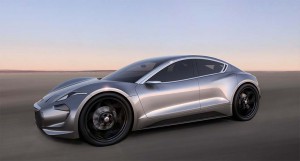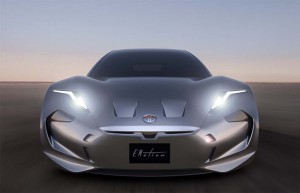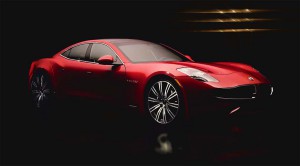If at first you don’t succeed…if you’re Henrik Fisker, it seems, you try and try again.
Best known for the sleek and iconic Aston Martin DB9, Henrik Fisker has attempted to launch two car companies since going out on his own a decade ago, including the ill-fated Fisker Automotive, the Danish designer is about get back into the business with a new pure battery-electric vehicle that could go beyond just being a Tesla-fighter. If the newly released images and specs prove accurate, the Fisker Emotion could rewrite the rules for the zero-emissions segment.
Beyond the car’s sleek design, the real breakthrough appears to be an alternative to the lithium-ion batteries used in most of today’s battery-based vehicles. Instead, the Emotion will use an ultracapacitor to store enough energy, the start-up claims, to run a “theoretical” 400 miles per charge.
There has been plenty of skepticism since the long-time designer announced his new, California-based Fisker Inc., and, arguably, for good reason considering the way his previous effort, Fisker Automotive, crashed and burned in spectacular fashion, its assets ultimately being sold off to the Chinese Wanxiang Group.
(That’s the same company that bought up Fisker Automotive’s former battery-supplier, A123, after it also went broke.)
Unlike his previous venture which focused on plug-in hybrids like its Fisker Karma, the new company is shifting gears to work exclusively on pure electric cars. But not battery vehicles. Instead, the power for the Emotion will come from an ultracapacitor, a technology that some have likened to storing energy in a bottle. Also known as supercapacitors, or electric double-layer capaciors, the concept dates back to research done by General Electric in the 1950s.
There are a number of commercial applications, including some LED streetlights and in medical defibrillators, for example, but automotive uses have been slim, with limited applications by Mazda, Toyota and PSA Peugeot Citroen.
Part of the problem is that conventional ultracapacitors can store and release energy rapidly, but they can’t take up a lot of energy at one time. Not compared to batteries, anyway. But Fisker claims to have gotten access to an all-new approach developed by researchers at UCLA using a Nobel Prize winning material called graphene.
It remains to be seen if, as Fisker claims, the graphene ulracapacitors really can store more power than comparable batteries. They will also have to prove reliable and cost competitive, and the automaker’s new Fisker Nanotech subsidiary will have to prove it can really manufacture the material in necessary volume. Those are big “ifs.”
But were the company to pull it off, Fisker could be in a position to leapfrog not only Tesla and other start-ups like Faraday Future, but also established automakers such as General Motors, Volkswagen and Daimler AG. The latter, the parent of both Smart and Mercedes-Benz, just broke ground for a second battery plant in Germany.
Checking out the Fisker Emotion reveals a design reminiscent of the original Fisker Karma – *which is now being built by Wanxiang subsdiary Karma and redesignated the Revero).
(Click Here for an initial review of the new Karma Revero.)
It’s a bit smoother of a design and features a grille-less nose, much like that of the Tesla Model S and newer Model 3. Aerodynamics clearly play a role in both sports car design and in the styling of an electric vehicle, especially one that Fisker promises wlll top out at 161 mph. Meanwhile, the promise is 400 miles range.
Along with wind-cheating features like its low nose and an integrated spoiler, the Fisker Emotion will get a sealed underbody. But the most visually distinctive touch is likely to be the use of dihedral doors. The approach could prove technically challenging, as Tesla has learned with the “falcon doors” on its Model X. But there already have been production vehicles with more common, if still exotic butterfly doors.
Another critical factor is mass, so the Fisker Emption will turn to weight-saving carbon fiber.
Fisker claims his new design will take advantage of the fact that with no big powertrain system in front of the driver you can recapture at least some of that space for the passenger compartment. As a result, he promises, there will be “superb rear legroom.” That’s no something you expect from a sports sedan.
On the technology side, expect to see adaptive headlights, an up-to-date infotainment system, a wide range of high-tech safety features and full autonomous capability. That will be purchased, Fisker said, from a “soon-to-be-announced supplier.” There are several, including German-based Continental Teves, and perhaps even Google, whom Fisker might be talking with.
(Daimler plans massive increase in battery production to support new Mercedes-EQ battery-car brand. Click Here for more.)
There are still a number of details yet to learn. Charging times, for one thing, though one of the advantages of current ultracapacitors is there ability to charge up far more rapidly than batteries. Price is another question, though Fisker is hinting at something on a par with the Tesla Model S.
As for timing, the plan is to roll out the Fisker Emotion later in 2017, the start-up looking to an “existing facility” in California. Where that might be is uncertain. Indeed, since the initial vehicle is expected to be produced in low volume, might it come out of a non-automotive plant?
Longer-term, Henrik Fisker recently told TheDetroitBureau.com that his new company wants to lift a page from the Tesla handbook. That would have it launch production with an expensive, high-performance halo car but eventually add more affordable products to its line-up.
Simply getting into production on that aggressive schedule will be a challenge, as Tesla has shown. But if Fisker can pull it off, and if its ultracapacitor system really lives up to its promise, the new company could have a strong future.
(Honda Clarity FCV to get 366 miles per tank of hydrogen. Click Here for the latest.)



